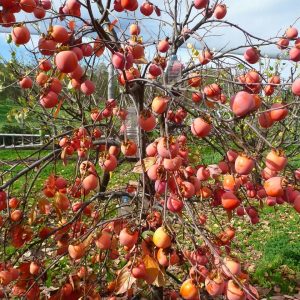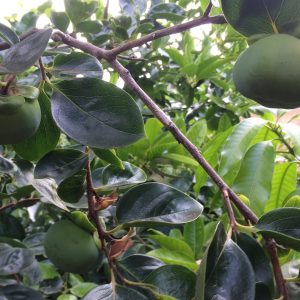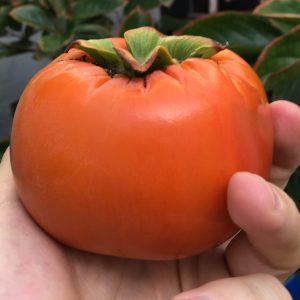Diospyros kaki
Persimmon
Origin
Native to China where, in addition to Korea and Japan, it has been grown for millennia. Annual World fruit production exceeded 2.5MT several years ago. D. kaki (hexaploid) is thought to have evolved from D. glandulosa (diploid).
Climate
It is a warm temperate, sub-tropical species that produces two types of fruit – astringent (A) and non-astringent (NA). The As will grow where grapes can be grown while the NAs require slightly warmer conditions. They have a low chill requirement (100hrs) but frosts may damage young growth and fruit. Mature trees may survive brief dry periods but cropping will be impacted. They have good tolerance of humidity.
Plant Description
Persimmon is a deciduous tree growing to about 6m tall with a naturally rounded and bushy canopy. The alternate simple green leaves are elliptic/ovate 7.5-22cm long by 5-10cm wide, leathery, glossy on the upper surface and brown-silky on the underside. They turn attractive colours of yellow, orange or red before abscising in Autumn. It has a strong tap root.
Relatives
Ebenaceae Family. Relatives include black sapote, mabolo, American persimmon and date plum. There are about 400 species in the genus.
Soils
Trees are not exacting in soil type but will do best in deep, well-drained loams with moderate to good fertility, pH 6.5-7.5.
Propagation
Most plants are propagated by grafting, commonly using whip and cleft grafts. Rootstocks can be from D. kaki seedlings or in colder climates, D. lotus (Date Plum) may be used. Seeds should be stratified before sowing.
Cultivars
There are many hundreds of these in Asia and elsewhere (really much less because of multiple assigned names) but most are unobtainable here. Some that can be sourced in WA include Fuyu, Suruga and Jiro (PCNA varieties) and Dai Dai Maru and Gapi Tipo (both A).
Flowering and Pollination
The flowers are inconspicuous surrounded by a green calyx tube, borne in leaf axils of new growth from one-year-old wood. Cream coloured female flowers are solitary and male are pink-tinged, borne in threes. There are 3 types of sex expression in persimmon flowering: only pistillate, both pistillate and staminate (monoecious); and hermaphrodite, pistillate and staminate (polygamomonoecious). Most commercial cultivars are pistillate, so monoecious cvs are interplanted to act as pollinators for trees that have low parthenocarpic properties. In monoecious cvs, good nutrient status and vigour predisposes towards pistillate flowers. Some fruits may set parthenocarpically but these are usually smaller than those where pollination has occurred. Bees and other insects pollinate the flowers.
Cultivation
Persimmons do not like root disturbance so care must be exercised when transplanting. Young plants need protection from the risk of sunburn, but when mature full sun is best. Trees need regular watering, 1000mm pa, mainly from Spring to Autumn. It is important that soil does not dry out during our hot Summer weather or you may lose the plant. Although many trees do well with a minimum of fertilizing, good yields may require regular applications, the amount depending on soil fertility and tree size. As a guide for a mature tree in sandy soil, 1kg NPK 8-4-9 or its equivalent in organic material could be used, half in late winter, a quarter after flowering and the rest after harvest. Too much results in vegetative rather than reproductive growth.
Wind Tolerance
In windy areas without protection, branches may break and there may be damaging fruit rub.
Pruning
When young, plants are most commonly trained to an open vase with 3-4 branches forming the main framework. Narrow crotch angles should be avoided. Trellising may be suitable to protect from winds and support heavy fruit loads. Alternate bearing is common and can be minimised by thinning fruit in heavy years; fruit thinning also has the advantage of producing larger fruit.
The Fruit
The spherical to oblate berry fruit has a persistent basal calyx with glossy smooth skin which can be yellow or orange through to brownish-red. Flesh is gelatinous and juicy with a similar colour range and can be either seedless or with 4-8 flat, oblong brown seeds, 2 cm long. Developing fruit are highly astringent due to soluble tannins, but the NAs lose astringency naturally as they develop. Within each of these two types there are cvs that are pollination constant (PC) and pollination variant (PV). Flesh colour variably darkens around the seeds in PVA and PVNA types when pollinated. The A types must be ripened to jam-like consistency to lose their tannins and be edible fresh. The PCNAs are edible while still crisp independent of pollination, whereas the PVNAs are only edible when firm if they have been pollinated. There is often considerable fruit drop by trees. Persimmons are good sources of Vitamins A and C and contain 15-20% sugars.
Fruit Production and Harvesting
Grafted plants may fruit within 3 years with full production in 7-10 years. Persimmons should be clipped from the tree when they are fully coloured, leaving a short stem and the calyx. Even though hard, fruit bruise easily. The A cvs should still be firm and will then ripen indoors.
Fruit Uses
Fruit are usually eaten fresh, but they’re also processed in many ways such as flavouring ice-creams and yoghurts, pastries, puddings, jams and jellies. Ripe fruit can be frozen whole or pureed. Drying makes a particularly tasty product.
Non-astringent types are eaten fresh while they are firm and crunchy. The astringent ones need to be very soft, ripe and jam-like when they become very sweet. Astringent persimmons, when frozen, are excellent to blend with other fruits and contain enough liquid to make a cold drink like a thick milk shake.
Pests and Diseases
Generally the high tannin levels in immature fruit guard against many pests and diseases. Birds and Med fly are the enemy in the Perth region. Control measures may require bagging or netting and spraying or baiting.
Comments
This exotic species can be grown here in south west WA, producing delicious fruit which are otherwise expensive. Like the Japanese, most Australians prefer the NA varieties, with Fuyu leading the pack. Another plus is that it ripens in autumn/winter when many other fruit are not in season. Market preferences are for seedless fruit, as with, eg, grapes and watermelon.


